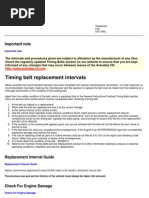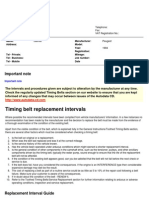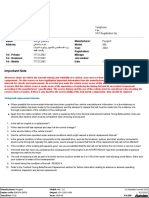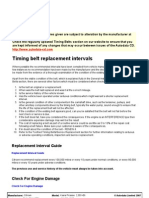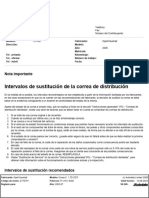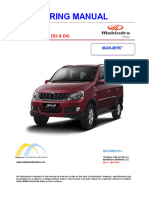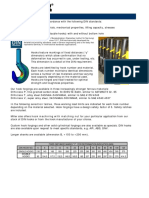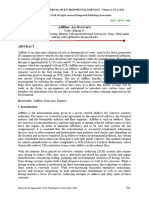Important Note: Timing Belt Replacement Intervals
Important Note: Timing Belt Replacement Intervals
Uploaded by
LUIS CONDORICopyright:
Available Formats
Important Note: Timing Belt Replacement Intervals
Important Note: Timing Belt Replacement Intervals
Uploaded by
LUIS CONDORIOriginal Description:
Original Title
Copyright
Available Formats
Share this document
Did you find this document useful?
Is this content inappropriate?
Copyright:
Available Formats
Important Note: Timing Belt Replacement Intervals
Important Note: Timing Belt Replacement Intervals
Uploaded by
LUIS CONDORICopyright:
Available Formats
Telephone:
Fax:
VAT Registration No.:
Important Note
All service items are vital to the smooth running and reliability of a vehicle, none more so than the timing belt and its associated
components. For this reason we have highlighted important information from the manufacturers' service schedules covering the
intervals for checks and replacements. Be sure that you make the vehicle owner aware of this information. Industry best practice is
to ensure that the vehicle owner is made aware of the importance of replacing the timing belt and its associated components
according to the manufacturers' specification. The service history and the use of the vehicle must be considered when deciding the
correct course of action. If there is any doubt to the serviceability of the belt and its components, they should be replaced.
Timing belt replacement intervals
Where possible the recommended intervals have been compiled from vehicle manufacturers' information. In a few instances no
recommendation has been made by the manufacturer and the decision to replace the belt must be made from the evidence of a
thorough examination of the condition of the existing belt.
Apart from the visible condition of the belt, which is explained fully in the General Instructions/Toothed Timing Belts section, there are
several other factors which must be considered when checking a timing belt:
1. Is the belt an original or a replacement?
2. When was the belt last replaced and was it at the correct mileage?
3. Is the service history of the vehicle known?
4. Has the vehicle been operated under arduous conditions which might warrant a shorter replacement interval?
5. Is the general condition of other components in the camshaft drive, such as the tensioner, pulleys, and other ancillary components
driven by the timing belt, typically the water pump, sound enough to ensure that the life of the replacement belt will not be affected?
6. If the condition of the existing belt appears good, can you be satisfied that the belt will not fail before the next check or service is due?
7. If the belt does fail, have you considered the consequences? If the engine is an INTERFERENCE type then considerable expensive
damage may well be the result.
8. The cost of replacing a belt as part of a routine service could be as little as 5 to 10% of the repair cost following a belt failure. Make sure
your customer is aware of the consequences.
9. If in doubt about the condition of the belt - RENEW it.
10. Refer to the Toothed Timing Belts/Service Replacement section for further information relating to arduous or adverse operating
conditions, inspection and service replacement.
Check For Engine Damage
CAUTION: This engine has been identified as an INTERFERENCE engine in which the possibility of valve-to-piston damage
in the event of a timing belt failure is MOST LIKELY to occur.
A compression check of all cylinders should be performed before removing the cylinder head.
Repair Times - hrs
Manufacturer: Toyota Model: Carina E 2,0D (c) Autodata Limited 2013
Engine code: 2C Output: 53 (72) 4600 . 6/09/2019
Tuned for: Year: 1992-96 V9.200-
Camshaft drive belt/chain - R & I 2,30
Camshaft drive belt/chain, AC - R & I 2,40
Special Tools
None required.
Special Precautions
Disconnect battery earth lead.
DO NOT turn crankshaft or camshaft when timing belt removed.
Remove glow plugs to ease turning engine.
Turn engine in normal direction of rotation (unless otherwise stated).
DO NOT turn engine via camshaft or other sprockets.
Observe all tightening torques.
Check diesel injection pump timing after belt replacement.
Removal
1. Remove:
Auxiliary drive belt(s).
PAS pump.
Cooling fan (RWD).
Timing belt upper cover [1] .
2. Turn crankshaft clockwise until timing marks aligned [2] & [3] .
3. Remove:
Crankshaft pulley bolt [9] .
Crankshaft pulley [5] .
Timing belt lower cover [6] .
4. Ensure timing marks aligned [4] .
5. Support engine (FWD).
6. Remove:
RH engine mounting (FWD).
Cooling fan bracket (RWD).
Engine mounting bracket (FWD).
Tensioner spring [7] .
7. Slacken tensioner bolt [8] .
8. Remove timing belt.
Installation
1. Check free length of tensioner spring is 51,93 mm. Replace spring if necessary.
2. Ensure timing marks aligned [2] & [3] .
Manufacturer: Toyota Model: Carina E 2,0D (c) Autodata Limited 2013
Engine code: 2C Output: 53 (72) 4600 . 6/09/2019
Tuned for: Year: 1992-96 V9.200-
3. Fit timing belt.
NOTE: Ensure numbers/letters on belt can be read from rear of engine.
4. Fit tensioner spring [7] .
5. Turn crankshaft two turns clockwise until timing marks aligned [2] & [3] .
6. Tighten tensioner bolt [8] . Tightening torque: 37 Nm.
7. Install components in reverse order of removal.
8. Tighten crankshaft pulley bolt [9] .
Except Carina E/Corolla (2C-E)/Avensis: Tightening torque: 98 Nm.
Carina E/Corolla (2C-E)/Avensis: Tightening torque: 196 Nm.
9. Lite-Ace: Reset timing belt replacement warning lamp as follows: Remove grommet in speedometer housing. Depress switch using a
thin screwdriver [10] .
Manufacturer: Toyota Model: Carina E 2,0D (c) Autodata Limited 2013
Engine code: 2C Output: 53 (72) 4600 . 6/09/2019
Tuned for: Year: 1992-96 V9.200-
Manufacturer: Toyota Model: Carina E 2,0D (c) Autodata Limited 2013
Engine code: 2C Output: 53 (72) 4600 . 6/09/2019
Tuned for: Year: 1992-96 V9.200-
You might also like
- Turner Compact Plus Transmission Manual PDFDocument74 pagesTurner Compact Plus Transmission Manual PDFJonathan Pais88% (8)
- 303-01 - 2.3L EcoBoost - Assembly - EngineDocument106 pages303-01 - 2.3L EcoBoost - Assembly - EngineCARLOS LIMADA100% (1)
- QuickServe Online - (4367454) QSK60 CM2250 K112 Service ManualDocument11 pagesQuickServe Online - (4367454) QSK60 CM2250 K112 Service ManualVanHoang100% (1)
- 1983 Data-Tech Chevrolet S10 2.8L Vin B Especificaciones de Motor EspecificacionesDocument24 pages1983 Data-Tech Chevrolet S10 2.8L Vin B Especificaciones de Motor EspecificacionesRubenNo ratings yet
- Course Specification of Automotive EngineeringDocument16 pagesCourse Specification of Automotive EngineeringAbdalmalek shamsanNo ratings yet
- Toyota 2AD-FHVDocument3 pagesToyota 2AD-FHVТимNo ratings yet
- Deere - trs22 UserManualDocument23 pagesDeere - trs22 UserManualcimbom1979No ratings yet
- 303-01 - 2.3L EcoBoost - Removal and Installation - CamshaftsDocument16 pages303-01 - 2.3L EcoBoost - Removal and Installation - CamshaftsCARLOS LIMADA100% (1)
- Engine: 303-01C Engine - 3.2L Duratorq-Tdci (148Kw/200Ps) - Puma 2011 - 2014 Ranger AssemblyDocument23 pagesEngine: 303-01C Engine - 3.2L Duratorq-Tdci (148Kw/200Ps) - Puma 2011 - 2014 Ranger AssemblyCamille Fajardo Danganan100% (2)
- LD23 Timing - Belt ProcedureDocument4 pagesLD23 Timing - Belt ProcedureNaomi Marty100% (2)
- Foote-Jones 8000 Series Gear Reducer ManualDocument20 pagesFoote-Jones 8000 Series Gear Reducer ManualbwelzNo ratings yet
- Repairing Jaeger & Smiths SpeedometersDocument25 pagesRepairing Jaeger & Smiths SpeedometersMichael Carnell100% (2)
- Engine Fault Codes (MID, PID, SID, FMI) FREIGHTLINERDocument12 pagesEngine Fault Codes (MID, PID, SID, FMI) FREIGHTLINERhaviettuan100% (1)
- Potno Motor Honda AcordDocument3 pagesPotno Motor Honda Acordtomas.eposNo ratings yet
- Ponto Motor MasterDocument3 pagesPonto Motor Mastertomas.eposNo ratings yet
- Distributie Y61 - Motor 2.8 DDocument4 pagesDistributie Y61 - Motor 2.8 DRoxana PetraNo ratings yet
- Timing Belt Replacement Interva CabrletDocument5 pagesTiming Belt Replacement Interva CabrletDavid MedlicottNo ratings yet
- 2.0 HDI Crankshaft AjustablDocument5 pages2.0 HDI Crankshaft Ajustablhike algeriaNo ratings yet
- Pegeaut Neu-Varianta 1Document6 pagesPegeaut Neu-Varianta 1Roxana PetraNo ratings yet
- 2001 Fiat Ducato 2,8TD Timing BeltDocument4 pages2001 Fiat Ducato 2,8TD Timing Beltca vaNo ratings yet
- Ponto Motor Nissan SunnyDocument4 pagesPonto Motor Nissan Sunnytomas.eposNo ratings yet
- Distributie VW Golf Estate 1996 - 1.9 66 KWDocument5 pagesDistributie VW Golf Estate 1996 - 1.9 66 KWRoxana PetraNo ratings yet
- 2010 Golf GTD TBKDocument6 pages2010 Golf GTD TBKChris BlackNo ratings yet
- Timing Belt HiJet 1995Document4 pagesTiming Belt HiJet 1995telematico69No ratings yet
- Important Note: Timing Belt Replacement IntervalsDocument3 pagesImportant Note: Timing Belt Replacement IntervalsRonnie WilliamNo ratings yet
- Important NoteDocument4 pagesImportant NoteAlfonso Chumbes ArangoNo ratings yet
- Chevrolet 2ho 1.8lDocument9 pagesChevrolet 2ho 1.8lrectificamosNo ratings yet
- Timing Belt Replacement Intervals: Important NoteDocument4 pagesTiming Belt Replacement Intervals: Important NotetrondNo ratings yet
- Important Note: Timing Belt Replacement IntervalsDocument5 pagesImportant Note: Timing Belt Replacement IntervalsAbdulmaola AlmamariNo ratings yet
- Puesta A Punto L200 4d56 2014Document5 pagesPuesta A Punto L200 4d56 2014ChristianHuiscañancoPerezNo ratings yet
- SeatDocument5 pagesSeatIbra HimNo ratings yet
- VW Passat - 3bg - Lay - DistributieDocument6 pagesVW Passat - 3bg - Lay - DistributieRoxana PetraNo ratings yet
- Freelander 20DT Timing Belt ReplacementDocument6 pagesFreelander 20DT Timing Belt ReplacementЯвор Матеев100% (1)
- Timing Belt Replacement 2HDIDocument5 pagesTiming Belt Replacement 2HDIwicka3No ratings yet
- Vera CruzDocument2 pagesVera CruzQuốc Phú Đinh100% (2)
- Correa PDFDocument5 pagesCorrea PDFjoderparaelnombreNo ratings yet
- 1HD, KZ Timing Belt Lc42tdDocument4 pages1HD, KZ Timing Belt Lc42tdavm53No ratings yet
- Timing Belt Replacement IntervalDocument5 pagesTiming Belt Replacement IntervalraulUTCNNo ratings yet
- Z 17 DTHDocument4 pagesZ 17 DTHpablo valdebenitoNo ratings yet
- Sorento ChainDocument3 pagesSorento ChainSudura Si Reparatii ACNo ratings yet
- Volvo V50 2005 2,0D 100kWDocument5 pagesVolvo V50 2005 2,0D 100kWASas TutuNo ratings yet
- Valve Timing Procedures: Linked To The Old, Passed Round The Sprockets and Then JoinedDocument2 pagesValve Timing Procedures: Linked To The Old, Passed Round The Sprockets and Then JoinedJohn GumbozNo ratings yet
- Banks SidewinderDocument20 pagesBanks Sidewinderpino2234No ratings yet
- Service Action RecallDocument6 pagesService Action Recallsaboor ashrafNo ratings yet
- Arbol de LevasDocument6 pagesArbol de Levasjulio cesarNo ratings yet
- Gear 2011 2.5Document2 pagesGear 2011 2.5Thanh OBD Lê ĐônNo ratings yet
- HTC AIR cool manual_compressedDocument70 pagesHTC AIR cool manual_compressedMohamed AliNo ratings yet
- 303-01 - 2.3L EcoBoost - Removal and Installation - Oil PumpDocument22 pages303-01 - 2.3L EcoBoost - Removal and Installation - Oil PumpCARLOS LIMADANo ratings yet
- Operation Manual: ENGLISCH - Kapitel 00 - Seite 1Document104 pagesOperation Manual: ENGLISCH - Kapitel 00 - Seite 1Gonzalo_Fernandez8477% (13)
- BMW Lanac UzubljivanjeDocument3 pagesBMW Lanac UzubljivanjeNikola Porki100% (1)
- 303-01 - 2.3L EcoBoost - Removal and Installation - Crackshaft PulleyDocument21 pages303-01 - 2.3L EcoBoost - Removal and Installation - Crackshaft PulleyCARLOS LIMADANo ratings yet
- F37 RecallDocument36 pagesF37 RecallchdorseyNo ratings yet
- Correa DistribucionDocument3 pagesCorrea DistribucionAlvaro GisbertNo ratings yet
- Installation InstructionsDocument40 pagesInstallation InstructionsMikko Reiska RaudusNo ratings yet
- Grand Vitara SZDocument3 pagesGrand Vitara SZJosé NavarreteNo ratings yet
- Timing Chain - 2003 Toyota Camry Sedan l4-2Document10 pagesTiming Chain - 2003 Toyota Camry Sedan l4-2ftafedeNo ratings yet
- Mazda TSB 01-007-09Document3 pagesMazda TSB 01-007-09Brett.HNo ratings yet
- G4FC-ElantraDocument2 pagesG4FC-ElantraIvan CmcNo ratings yet
- 303-14 Electronic Engine Controls - Removal and Installation - Camshaft Position CMP SensorDocument6 pages303-14 Electronic Engine Controls - Removal and Installation - Camshaft Position CMP SensorCARLOS LIMADANo ratings yet
- Repair Instructions - Off Vehicle PDFDocument37 pagesRepair Instructions - Off Vehicle PDFFernando Ortiz100% (1)
- Plymouth and Chrysler-built cars Complete Owner's Handbook of Repair and MaintenanceFrom EverandPlymouth and Chrysler-built cars Complete Owner's Handbook of Repair and MaintenanceNo ratings yet
- Tractor Principles: The Action, Mechanism, Handling, Care, Maintenance and Repair of the Gas Engine TractorFrom EverandTractor Principles: The Action, Mechanism, Handling, Care, Maintenance and Repair of the Gas Engine TractorNo ratings yet
- MG Midget & A-H Sprite: Your expert guide to common problems & how to fix themFrom EverandMG Midget & A-H Sprite: Your expert guide to common problems & how to fix themNo ratings yet
- 90° Dual Band Panel Antenna: General SpecificationsDocument2 pages90° Dual Band Panel Antenna: General SpecificationsJonathan Gonzalez.LNo ratings yet
- Om - S70 Metric - 11 - 2014Document30 pagesOm - S70 Metric - 11 - 2014TucumánElectricidadIndustrialNo ratings yet
- AR05.30-B-3731G.fm Check, Remove and Install The Valve Guides 18.11.03Document4 pagesAR05.30-B-3731G.fm Check, Remove and Install The Valve Guides 18.11.03LUKASNo ratings yet
- Manual CarroceroDocument78 pagesManual CarroceroPedro LeosNo ratings yet
- Aluminium Alloys Used in The Marine IndustryDocument7 pagesAluminium Alloys Used in The Marine IndustryAniekanNo ratings yet
- CAT - Hydraulic Tooling 5 - 15Document12 pagesCAT - Hydraulic Tooling 5 - 15danielNo ratings yet
- Tri MotorManualDocument14 pagesTri MotorManualdimiNo ratings yet
- MAN 00187 Xylo mDiCRDe Wiring ManualDocument122 pagesMAN 00187 Xylo mDiCRDe Wiring ManualEduardo Antonio Barria Ojeda100% (1)
- Miller 09Document5 pagesMiller 09sarochimNo ratings yet
- Páginas desdeMASTER-WAGNER-2023Document32 pagesPáginas desdeMASTER-WAGNER-2023juan carlos cruzNo ratings yet
- Easa Biweekly 18-2021Document2 pagesEasa Biweekly 18-2021yuhusaNo ratings yet
- Service Manual: Chassis & Mast E3000, E3500, EC4000Document9 pagesService Manual: Chassis & Mast E3000, E3500, EC4000Kevin Daughton0% (3)
- Me 463-Machine Design 2: Instructor: Engr. Danielle D. Cabana, MengDocument27 pagesMe 463-Machine Design 2: Instructor: Engr. Danielle D. Cabana, MengChristian Breth BurgosNo ratings yet
- Rtad 085Document84 pagesRtad 085Omar Piña100% (1)
- Lesson 3 Collision Related Damages and InjuriesDocument28 pagesLesson 3 Collision Related Damages and Injurieskenjigomez826No ratings yet
- Robotics in The EnterpriseDocument64 pagesRobotics in The EnterpriseZeeshan HaiderNo ratings yet
- Nset.v28 32sDocument2 pagesNset.v28 32sمهند العراقيNo ratings yet
- Auction Schedule SEP2023 App East KarachiDocument9 pagesAuction Schedule SEP2023 App East KarachiCheck12345 TheNo ratings yet
- 06 TitanDocument152 pages06 TitanSergey SofferNo ratings yet
- 15-Luyện nghe Ielts - I'm HinaDocument18 pages15-Luyện nghe Ielts - I'm Hinachuminhhien1514No ratings yet
- Yadav AdBlueDocument9 pagesYadav AdBlueguilherme lacerdaNo ratings yet
- BIW Welding Fixture Design Domain TrainingDocument21 pagesBIW Welding Fixture Design Domain Trainingmohammad touffique100% (1)
- Vdocuments - MX - Flender Couplings Siemens 25 Ba 3001 en 062012 Flender Uzwn Overrunning ClutchesDocument25 pagesVdocuments - MX - Flender Couplings Siemens 25 Ba 3001 en 062012 Flender Uzwn Overrunning Clutchesmilad jafaryianNo ratings yet
- 300 Exc Tpi 2019 Eu 2019: Art.-Nr.: F7403s7enDocument44 pages300 Exc Tpi 2019 Eu 2019: Art.-Nr.: F7403s7enJeri Rizal Firdaus0% (2)
- tsf2 h2 Coalescing Filter Data Sheet enDocument4 pagestsf2 h2 Coalescing Filter Data Sheet enCLAUDIA RAMIREZ SAUCEDONo ratings yet
- Suzuki Pakistan @suzukipakistan Suzuki PakistanDocument10 pagesSuzuki Pakistan @suzukipakistan Suzuki Pakistanarshad mehmoodNo ratings yet









